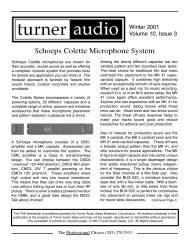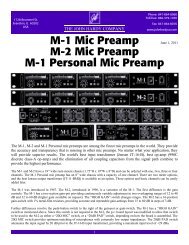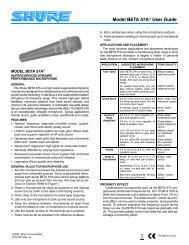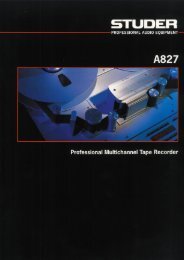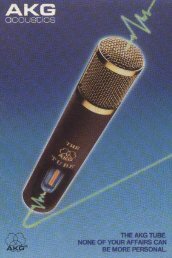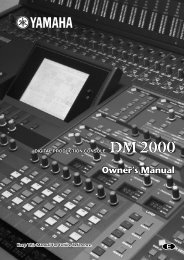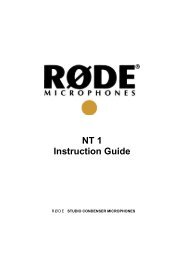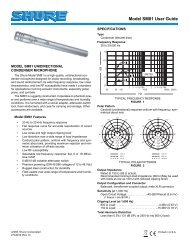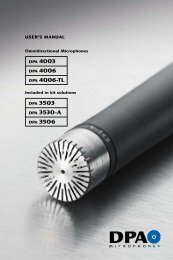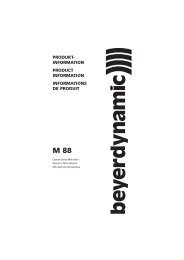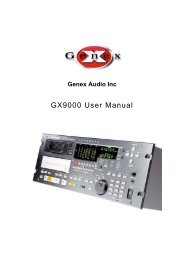B&K 4006 - SRTalumni.com
B&K 4006 - SRTalumni.com
B&K 4006 - SRTalumni.com
You also want an ePaper? Increase the reach of your titles
YUMPU automatically turns print PDFs into web optimized ePapers that Google loves.
User’s Manual<br />
Omnidirectional<br />
Microphones<br />
Type 4003<br />
Type <strong>4006</strong>
User’s Manual<br />
Contents<br />
Omnidirectional Microphones<br />
Type 4003, Type <strong>4006</strong><br />
Technical Description . . . . . . . . . . . . . . . . . . . . . . . Page 2<br />
Full Specifications . . . . . . . . . . . . . . . . . . . . . . . . . . Page 6<br />
Care of Microphones . . . . . . . . . . . . . . . . . . . . . . . Page 14<br />
Service and Repair . . . . . . . . . . . . . . . . . . . . . . . . . Page 16<br />
Warranty . . . . . . . . . . . . . . . . . . . . . . . . . . . . . . . . . Page 16<br />
CE Standard . . . . . . . . . . . . . . . . . . . . . . . . . . . . . . . Page 16
User’s Manual<br />
Technical Description<br />
The cartridge<br />
Types 4003 and <strong>4006</strong> are omnidirectional (pressure) microphones which use<br />
a 16mm diameter prepolarized condenser cartridge. The diaphragm is a nickel<br />
foil which has been coated with an ultra-thin polymer layer for optimum<br />
corrosion resistance. The microphone housing is of German silver, an alloy<br />
with a high content of nickel to match the stable thermal qualities of the<br />
diaphragm. The cartridge has low self noise (typical 15dB(A) re. 20µPa) and<br />
high sensitivity (4003: 45mV/Pa and <strong>4006</strong>: 10mV/Pa). For optimum stability<br />
the microphone cartridges have undergone a special pre-aging process which<br />
releases all tensions in the materials and stabilizes the polarization voltage.<br />
The preamplifier<br />
Types 4003 and <strong>4006</strong> are acoustically identical, but differ in their preamplifier<br />
powering system. The 4003 is powered with 130V via the HMA4000 High-<br />
Voltage Microphone Amplifier and has a modified 4-pin XLR-connector (see<br />
Fig. 1 for pin designation). This special powering system enables the microphone<br />
preamplifier to handle approximately 10dB higher SPL than similar<br />
microphone types powered through conventional P48 systems (4003: 154dB<br />
SPL peak and <strong>4006</strong>: 143dB SPL peak). Furthermore the 4003 together with the<br />
HMA4000 is a totally transformerless system and therefore has an extended<br />
low-frequency handling capability (10Hz to 20kHz ± 2dB). The <strong>4006</strong> is powered<br />
via a standard P48 system and is equipped with a standard 3-pin XLR-connector<br />
(see Fig. 2 for pin designation). Types 4003 and <strong>4006</strong> use state of the art<br />
low-noise preamplifier technology. The preamplifiers are driven with unity<br />
gain to keep noise as low as possible.<br />
2
User’s Manual<br />
Technical Description<br />
All microphones <strong>com</strong>e with an individual calibration chart with the<br />
specifications of self noise, sensitivity and the frequency response.<br />
Fig. 1. External view of the output socket of the Type 4003.<br />
Fig. 2. External view of the output socket of the Type <strong>4006</strong>.<br />
Important: The microphones will only live up to their specifications if<br />
powered correctly.<br />
3
User’s Manual<br />
Technical Description<br />
The Nearfield Grid<br />
The Nearfield Grid DD0251 on the microphone cartridge is designed to have<br />
a linear on-axis frequency response for near field applications (see Fig. 3 for<br />
frequency responses measured with the Nearfield Grid). The grid can be<br />
exchanged with the DD0297 Diffusefield Grid or the UA0777 Nose Cone.<br />
The Diffusefield Grid<br />
The Diffusefield Grid DD0297 is supplied as standard. It is designed for diffusefield<br />
recordings, or recordings in the far field. The grid gives a high-frequency<br />
boost on-axis of 6dB around 15kHz (see Fig. 4) without adding noise to the<br />
recording. This boost gives a linear diffuse-field (far field) response up to 15kHz.<br />
The Nose Cone<br />
The Nose Cone UA0777 is available as an optional accessory . As with the<br />
Diffusefield Grid DD0297, the Nose Cone is simply screwed onto the microphone<br />
cartridge in place of the Nearfield Grid DD0251. When fitted, the<br />
Nose Cone gives the microphone a true omnidirectional response even at<br />
high frequencies (see Fig. 7) and a linear diffuse-field response (see Fig. 5).<br />
These qualities are useful at any distance for an even tonal balance of sound<br />
arriving at all angles of incidence, e.g. room reverberation or several sound<br />
sources placed around the microphone. The diaphragm is placed in a slot<br />
behind the solid cone and sound waves only have access to the diaphragm<br />
through the side of the Nose Cone. This way the Nose Cone prevents an<br />
on-axis, high frequency sound pressure build-up on the microphone, which<br />
is the reason for normal flat fronted omnidirectional microphones be<strong>com</strong>ing<br />
more and more directional for higher frequencies. There is however, a slight<br />
high frequency boost on axis.<br />
4
User’s Manual<br />
Technical Description<br />
Acoustic Pressure Equalizers<br />
Available as optional acoustical attachments are also the APE’s – Acoustic<br />
Pressure Equalizers. The APE’s use diffraction to passively modify the sound<br />
field near the microphone diaphragm, thus changing the microphone’s<br />
frequency response and, in particular, the polar response (see Fig. 11 and Fig.<br />
12) without adding any electrical noise to the recording. The size and shape<br />
of the APE determines the acoustical changes of the microphone. The APE’s<br />
are precision made from a special <strong>com</strong>pact nylon material and will only fit<br />
the Types 4003 and <strong>4006</strong> fitted with the standard Nearfield Grid DD0251.<br />
There are four different APE’s in the range: L30B is a Ø30mm ball-shaped<br />
APE marked with a blue dot, L40B is a Ø40mm ball-shaped APE marked with<br />
a green dot, L50B is a Ø50 mm ball-shaped APE marked with a red dot and<br />
the L110C is a cylinder-shaped APE, 110mm long and marked with a yellow<br />
dot. The APE’s can be obtained as single units or in two different equalizer<br />
kits: APE L4 contains 4 different APE’s and APE L8 contains 2x4 different<br />
APE’s. See Fig. 14 for how to mount the APE’s on the microphones.<br />
The Passive Connection Converter<br />
The PCC4000 Passive Connection Converter is an optional accessory that<br />
makes it possible to run High-Voltage Microphones on standard 48 V<br />
phantom power with reduced microphone specs. The maximum reduction of<br />
the microphone SPL handling capability will be 13dB and it is possible to<br />
drive up to 100m of cable with the PCC4000 with the same specifications.<br />
Like the High-Voltage Microphones the PCC4000 is transformerless. The<br />
input connector is a modified 4-pin female XLR for connection directly to<br />
the microphone. The output is a standard 3-pin male XLR-connector for<br />
connection to standard cables.<br />
5
User’s Manual<br />
Full Specification<br />
Cartridge type: Pre-polarized condenser B&K Type MM0042<br />
Principle of operation: Pressure<br />
Power Supply: 4003: HMA4000 Two-channel High-Voltage Microphone<br />
Amplifier - 130V or PCC4000 Passive Connection<br />
Converter for P48<br />
<strong>4006</strong>: Phantom P48<br />
Frequency range: 4003: On-axis: 10Hz - 20kHz ±2dB<br />
<strong>4006</strong>: On-axis: 20Hz - 20kHz ±2dB up to 124dB peak<br />
Phase response: See Fig. 8 and 9. Phase matching between any two<br />
microphones: ±10°<br />
Directional characteristics: Omnidirectional<br />
Sensitivity: 4003: Nominally 40mV/Pa; -27dB re. 1V/Pa unloaded (at 250Hz)<br />
<strong>4006</strong>: Nominally 10mV/Pa; -40dB re. 1V/Pa unloaded (at 250Hz)<br />
Equivalent noise level A-weighted: Typ. 15dB(A) re. 20µPa (max. 17dB(A))<br />
Equivalent noise level CCIR 468-1: Typ. 27dB (max. 29dB)<br />
Max SPL: 4003: 154dB SPL peak (f< 4kHz)<br />
4003: 151dB SPL peak (f< 14kHz)<br />
<strong>4006</strong>: 143dB SPL peak (f > 200Hz)<br />
Total Harmonic Distortion: 129 dB SPL peak (
User’s Manual<br />
Full Specification<br />
Polarity: 4003: Positively increasing sound pressure produces positive-going<br />
voltage at pin 4. Pin 1: Ground, Pin 2: Not used, Pin 3: 130 V DC<br />
preamplifier supply, Pin 4: Signal. See Fig. 1.<br />
<strong>4006</strong>: Positively increasing sound pressure produces positive-going<br />
voltage at pin 2. Pin 1: Ground, Pin 2: Signal +, Pin 3: Signal return.<br />
See Fig. 2<br />
Difference frequency distortion: (DF2, DF3, Df = 80Hz)
User’s Manual<br />
Full Specification<br />
Accessories Available<br />
Shock Mounts<br />
RSM4000 Shock Mount for<br />
Windjammer<br />
UA0897 Shock Mount<br />
Shock Mount Rubbers<br />
DDS0731 Rubber Mount 19mm,<br />
Medium Soft<br />
Microphone Holders &<br />
Suspension Mounts<br />
UA0961 Microphone Holder<br />
Stereo Accessories<br />
UA0836<br />
UA0837<br />
Stereo Boom with Holders<br />
Stereo Boom<br />
excluding Holders<br />
Floor & Table Stands<br />
MB4000 Magnet Base<br />
TB4000 Table Base<br />
Acoustic Modification Accessories<br />
APE L4 Acoustic Modification Kit,<br />
Mono<br />
APE L8 Acoustic Modification Kit,<br />
Stereo<br />
L110C Acoustic Pressure Eq.,<br />
110mm Cylinder<br />
L30B Acoustic Pressure<br />
Equalizer, 30mm Ball<br />
L40B Acoustic Pressure<br />
Equalizer, 40mm Ball<br />
L50B Acoustic Pressure<br />
Equalizer, 50mm Ball<br />
UA0777 Nose Cone<br />
Connection Adapters<br />
HTP4000 Converter: 130V to P48<br />
PCC4000 Passive Connection<br />
Converter: P48 to 130V<br />
Cables<br />
AO0182 P48 Microphone Cable, 5m<br />
AO0261 130V Microphone Cable,<br />
5m (Type 2812)<br />
DAO0130 130V Microphone Cable,<br />
5m (Type HMA4000)<br />
8<br />
Fig. 3. On-axis and diffuse-field responses of Types 4003 and <strong>4006</strong> with the Nearfield<br />
Grid DD0251 fitted.
User’s Manual<br />
Full Specification<br />
Fig. 4. On-axis and diffuse-field responses of Types 4003 and <strong>4006</strong> with the<br />
Diffusefield Grid DD0297 fitted.<br />
Fig. 5. Diffuse-field response of Types 4003 and <strong>4006</strong> with Nose Cones UA0777 fitted.<br />
Fig. 6.<br />
Directional characteristics of<br />
Types 4003 and <strong>4006</strong> with Nearfield<br />
Grid DD0251 fitted.<br />
9
User’s Manual<br />
Full Specification<br />
Fig. 7.<br />
Normalised directional<br />
characteristics of Types<br />
4003 and <strong>4006</strong> with Nose<br />
Cone UA0777 fitted.<br />
Fig. 8. On-axis amplitude and phase responses of Types 4003 and <strong>4006</strong><br />
plotted using a linear frequency axis for evaluation of the phase response.<br />
10
User’s Manual<br />
Full Specification<br />
Fig. 9. On-axis low frequency amplitude and phase response of Types 4003 and <strong>4006</strong>.<br />
Fig. 10. Typical third-octave inherent-noise spectrum of Type <strong>4006</strong>.<br />
11
User’s Manual<br />
Full Specification<br />
Fig. 11. Response characteristics of APE L30B (top), APE L40B, APE L50B and APE L110C.<br />
12
User’s Manual<br />
Full Specification<br />
Fig. 12. Directional characteristics of APE L30B (top left), APE L40B, (top right), APE L50B<br />
and APE L110C.<br />
13
It is important to bear in mind the following points with regards to<br />
mounting, microphone care and the use of accessories:<br />
• The microphone cartridge is tightly secured to the main body housing,<br />
and no attempt should be made to remove it. If a replacement cartridge<br />
is required, contact your local DPA Microphones representative.<br />
• Types 4003 and <strong>4006</strong> are supplied with an additional Diffusefield Grid<br />
DD0297 (see “Technical Description” and “Full Specifications”). On<br />
delivery, the normal protection grid is screwed on to the cartridge<br />
housing and normal finger torque is required to remove it. Do not try to<br />
unscrew or tighten the protection grids with any kinds of tools as both<br />
surface and thread might be damaged.<br />
• Caution: When changing grids, be very careful to avoid any contact<br />
with the diaphragm. Over time a visible dust layer can build up on the<br />
diaphragm. Since the mass added is extremely small and the influence<br />
on the frequency response is negligible, the dust will not change the<br />
characteristics of the microphone. Therefore cleaning the diaphragm is<br />
not necessary and must not be done.<br />
• Use of windscreen is re<strong>com</strong>mended<br />
when microphones are used in dirty<br />
or dusty environments.<br />
User’s Manual<br />
Care Of Microphones<br />
• When not in use, the microphone<br />
should be disconnected and kept in<br />
the case supplied.<br />
Fig. 13. Be careful to<br />
avoid any contact<br />
with the diaphragm.<br />
14
User’s Manual<br />
Care Of Microphone<br />
Use of Acoustic Pressure Equalizers<br />
• Acoustic Pressure Equalizers are only to be used with the standard<br />
silver protection grid DD0251.<br />
• Do not try to fit APE’s on Nose Cone UA0777.<br />
• The microphone must be inserted into the APE hole from the end which<br />
is opposite to the O-ring. Push the microphone through the hole gently;<br />
apply a small amount of force when the microphone passes the O-ring<br />
and is locked. Never turn the microphone or the APE, since this may<br />
cause a tightening or loosening of the grids. When positioned correctly,<br />
the APE is flush with the diaphragm.<br />
• Caution: During insertion of the microphone do not place a finger or a<br />
palm across the hole, as air confined in the hole may cause the<br />
diaphragm to crack.<br />
• When dismounting the APE, use a thumb to press it off. Never turn the<br />
microphone or the APE.<br />
Fig. 14.<br />
Correct mounting and<br />
dismounting of APE’s.<br />
1. Correct direction for mounting<br />
and dismounting APE’s.<br />
2. The APE must be positioned so<br />
that it is flush with the diaphragm.<br />
3. To avoid separation of the<br />
microphone or tightening of the<br />
grid, do not turn the microphone.<br />
15
User’s Manual<br />
Service & Repair<br />
Service & Repair<br />
Products from DPA Microphones are extremely stable and there should not<br />
be any significant change in the specifications with time and use. If, however,<br />
you are not totally satisfied with the characteristics exhibited by these<br />
products, then contact your nearest DPA Microphones representative for<br />
further details of service and the repair facilities that are available.<br />
DPA Microphones has a maximum seven working days in-house service<br />
policy, guaranteeing that no more than seven working days will elapse from<br />
the day we receive the item for service to the day we are ready to return it<br />
to you. Your satisfaction is our satisfaction.<br />
Please contact DPA Microphones for your nearest representative on<br />
tel. +45 48 14 28 28 or fax +45 48 14 27 00.<br />
Warranty<br />
All products from DPA Microphones are covered by a limited warranty on<br />
both their mechanical functionality and their documented specifications.<br />
We are so confident of the quality of these products, that this warranty is<br />
valid for one year from the date of purchase, as long as the items are not<br />
directly mistreated or abused. In case of a warranty claim, your invoice is<br />
your warranty registration.<br />
CE Standard<br />
The CE-mark guarantees all products conform with relevant standards<br />
approved by the European Community. The products described in this User’s<br />
Manual <strong>com</strong>ply with current relevant standards when used with cables from<br />
DPA Microphones.<br />
EMC Directive: 89/336/EEC, amended by 92/31/EEC and 93/68/EEC<br />
Low Voltage Directive: 73/23/EEC, amended by 93/68/EEC<br />
16
Gydevang 44 • Dk-3450 Allerød • Denmark<br />
tel: +45 4814 2828 Fax: +45 4814 2700<br />
http://www.dpamicrophones.<strong>com</strong><br />
email: info@dpamicrophones.<strong>com</strong>



